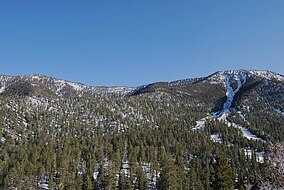Humboldt-Toiyabe National Forest
| Humboldt-Toiyabe National Forest | |
|---|---|
 The Humboldt-Toiyabe National Forest in the Spring Mountains | |
 | |
| Location | California and Nevada, United States |
| Nearest city | Reno, NV |
| Coordinates | 39°15′15″N 117°07′40″W / 39.254041°N 117.127767°W / 39.254041; -117.127767Coordinates: 39°15′15″N 117°07′40″W / 39.254041°N 117.127767°W / 39.254041; -117.127767 |
| Area | 6,289,821 acres (25,454.00 km2)[1] |
| Established | Humboldt July 1, 1908; Toiyabe March 2, 1907[2] |
| Governing body | U.S. Forest Service |
| Website | Humboldt-Toiyabe National Forest |
The Humboldt-Toiyabe National Forest (HTNF) is the principal U.S. National Forest in the U.S. state of Nevada, and has a smaller portion in Eastern California. With an area of 6,289,821 acres (25,454.00 km2), it is the largest National Forest of the United States outside Alaska.
Contents
1 Geography
1.1 Ranger Districts
1.2 Wilderness areas
1.2.1 Humboldt National Forest
1.2.2 Toiyabe National Forest
1.3 Counties
1.3.1 Nevada counties
1.3.2 California counties
2 References
3 External links
Geography

Lamoille Canyon Scenic Byway
HTNF does not resemble most other National Forests in that it has numerous fairly large but non-contiguous sections scattered about most of the state of Nevada and a portion of eastern California. Its 10 ranger districts are scattered across the many mountain ranges in Nevada, from the Santa Rosa Range in the north to the Spring Mountains near Las Vegas in the south. A part of the forest (about 11%) is in eastern California, in the areas around Bridgeport and Markleeville, and other areas east of the Sierra Nevada.
The forest lies in 13 counties in Nevada and 6 in California. The counties with the largest amount of forest land are Nye, Elko, and White Pine in Nevada, and Mono County in California, but there are 15 other counties with land in this widely dispersed forest. Forest headquarters are located in Sparks, Nevada.
- Humboldt National Forest section
The smaller and more northeasterly Humboldt National Forest is located generally in eastern and northern Nevada, in parts of Elko, White Pine, Humboldt, Nye, and Lincoln counties. It has about 43.5% of the total area. There are local ranger district offices located in Ely, Elko, Wells, and Winnemucca.
- Toiyabe National Forest section
The larger and more southwesterly Toiyabe National Forest is located generally in central, western, and southern Nevada and eastern California, in parts of Nye, Lander, Mineral, Lyon, Eureka, Washoe, Douglas, and Clark counties and Carson City in Nevada, and Mono, Alpine, Sierra, Nevada, Lassen, and El Dorado counties in California. It has about 56.5% of the total area. There are local ranger district offices located in Austin, Bridgeport, Carson City, Las Vegas, and Tonopah. (Bridgeport is the only station that is in California.)
Ranger Districts

Summer wildflowers in Copper Basin (Jarbidge and Mountain City ranger districts)
Austin Ranger District - around Austin, including Shoshone Mountains
- Bridgeport Ranger District - around Bridgeport
Carson Ranger District - near Carson City- Ely Ranger District - around Ely, Nevada
Jarbidge Ranger District - near Jarbidge
Mountain City Ranger District - near Mountain City
- Ruby Mountains Ranger District - Ruby Mountains and East Humboldt Range
- (formerly Ruby Mountains National Forest)
Spring Mountains National Recreation Area - Spring Mountains- Santa Rosa Ranger District - Santa Rosa Range
- Tonopah Ranger District - near Tonopah, Nevada, including Toiyabe Range, Toquima Range, Monitor Range, and Hot Creek Range
Wilderness areas

Copper Basin in the Jarbidge Wilderness
Humboldt National Forest

Lamoille Lake in the Ruby Mountains
- Bald Mountain Wilderness
- Currant Mountain Wilderness
- East Humboldt Wilderness
- Grant Range Wilderness
- High Schells Wilderness
- Jarbidge Wilderness
Mount Moriah Wilderness (partly BLM)- Quinn Canyon Wilderness
- Red Mountain Wilderness
- Ruby Mountains Wilderness
- Santa Rosa-Paradise Peak Wilderness
- Shellback Wilderness
- White Pine Range Wilderness
Toiyabe National Forest
- Alta Toquima Wilderness
- Arc Dome Wilderness
Carson-Iceberg Wilderness (partly in Stanislaus NF)
Hoover Wilderness (partly in Inyo NF)
La Madre Mountain Wilderness (mostly BLM)
Mokelumne Wilderness (mostly in Eldorado NF and partly in Stanislaus NF)[3]
Mount Charleston Wilderness (partly BLM)- Mount Rose Wilderness
Rainbow Mountain Wilderness (mostly BLM)- Table Mountain Wilderness
Counties

Lake Tahoe's eastern shoreline is within the Carson ranger district
In descending order of forest land area within the counties:[4]
Nevada counties
Nye, Elko, White Pine, Lander, Humboldt, Mineral, Lyon, Eureka, Washoe, Douglas, Clark, Lincoln, Carson City
California counties
Mono County, Alpine, Sierra, Nevada, Lassen, El Dorado
References
^ "Humboldt - Toiyabe National Forest webpage". U.S. Department of Agriculture. June 2014. Retrieved June 10, 2014..mw-parser-output cite.citation{font-style:inherit}.mw-parser-output q{quotes:"""""""'""'"}.mw-parser-output code.cs1-code{color:inherit;background:inherit;border:inherit;padding:inherit}.mw-parser-output .cs1-lock-free a{background:url("//upload.wikimedia.org/wikipedia/commons/thumb/6/65/Lock-green.svg/9px-Lock-green.svg.png")no-repeat;background-position:right .1em center}.mw-parser-output .cs1-lock-limited a,.mw-parser-output .cs1-lock-registration a{background:url("//upload.wikimedia.org/wikipedia/commons/thumb/d/d6/Lock-gray-alt-2.svg/9px-Lock-gray-alt-2.svg.png")no-repeat;background-position:right .1em center}.mw-parser-output .cs1-lock-subscription a{background:url("//upload.wikimedia.org/wikipedia/commons/thumb/a/aa/Lock-red-alt-2.svg/9px-Lock-red-alt-2.svg.png")no-repeat;background-position:right .1em center}.mw-parser-output .cs1-subscription,.mw-parser-output .cs1-registration{color:#555}.mw-parser-output .cs1-subscription span,.mw-parser-output .cs1-registration span{border-bottom:1px dotted;cursor:help}.mw-parser-output .cs1-hidden-error{display:none;font-size:100%}.mw-parser-output .cs1-visible-error{font-size:100%}.mw-parser-output .cs1-subscription,.mw-parser-output .cs1-registration,.mw-parser-output .cs1-format{font-size:95%}.mw-parser-output .cs1-kern-left,.mw-parser-output .cs1-kern-wl-left{padding-left:0.2em}.mw-parser-output .cs1-kern-right,.mw-parser-output .cs1-kern-wl-right{padding-right:0.2em}
^ "Land Areas of the National Forest System" (PDF). U.S. Forest Service. November 2014. Retrieved August 9, 2015.
^ "Acreage breakdown". Wilderness.net. Retrieved 2013-12-28.
^ http://www.fs.fed.us/land/staff/lar/2007/TABLE_6.htm
External links
| Wikimedia Commons has media related to Humboldt-Toiyabe National Forest. |
- Official website
- National Atlas: Map of Humboldt-Toiyabe National Forest
